2006 LEXUS LS430 towing
[x] Cancel search: towingPage 3 of 419

1
2
3
4
5
6
7
2-3. Operating the headlight and windshield wipers ..................... 110
Headlight switch ............................. 110
Fog light switch ................................ 113
Windshield wipers and
washer............................................... 114
Headlight cleaner switch ............. 117
2-4. Using other driving systems..... 118 Lexus park assist system ............. 118
Rear view monitor system ......... 123
Cruise control ................................ 126
Dynamic radar/ laser cruise
control............................................. 129
Electronically modulated air
suspension..................................... 138
Driver assist systems.................... 140
Pre-collision system
(if equipped) ................................. 143
2-5. Driving information ................... 145 Cargo & luggage .......................... 145
Vehicle load limits ......................... 148
Winter driving tips ........................ 149
Trailer Towing................................. 152
Dinghy towing ................................ 160
3-1. Using the air conditioning
system and defogger .............. 162 Automatic air conditioning
control............................................. 162
Rear window defogger ............... 170
Rear air conditioning controls .. 172
3-2. Using the audio system............. 174 Audio system ................................... 174
Operating the radio ...................... 176
Operating the cassette player............................................... 182
Using the CD changer ............... 185
Optimal use of the audio
system ............................................... 191
Using the rear controller ........... 193
Using the steering switches ...... 195
3-3. Turning on interior lights......... 198 Interior lights list............................. 198
3-4. Storage......................................... 201 Storage features ............................ 201
3-5. Other interior features .......... 208 Sun visors........................................ 208
Vanity mirror and light ............... 209
Clock.................................................. 210
Ashtray ................................................ 211
Cigarette li ghter
............................ 213
Power outlets .................................. 214
Outside temperature display ... 216
Seat heaters..................................... 218
Climate control seat
switches ......................................... 220
3Interior features
Page 101 of 419

2When driving
85
2-1. Driving procedures ................. 86Driving the vehicle ...................... 86
Starting the engine ...................... 94
Automatic transmission ............ 98
Turn signal lever ............................ 101
Parking brake .............................. 102
2-2. Instrument cluster .................. 103 Gauges and meters .................. 103
Indicators and warning
lights ............................................. 105
Multi-information display ........ 107
2-3. Operating the headlight and
windshield wipers .................. 110
Headlight switch .......................... 110
Fog light switch ............................. 113
Windshield wipers and
washer ........................................... 114
Headlight cleaner switch.......... 117 2-4. Using other driving
systems ..................................... 118
Lexus park assist system ........... 118
Rear view monitor system....... 123
Cruise control .............................. 126
Dynamic radar/ laser cruise
control .......................................... 129
Electronically modulated air
suspension.................................. 138
Driver assist systems ................. 140
Pre-collision system
(if equipped) .............................. 143
2-5. Driving information ................ 145 Cargo & luggage ....................... 145
Vehicle load limits....................... 148
Winter driving tips...................... 149
Trailer Towing ............................... 152
Dinghy towing.............................. 160
Page 114 of 419
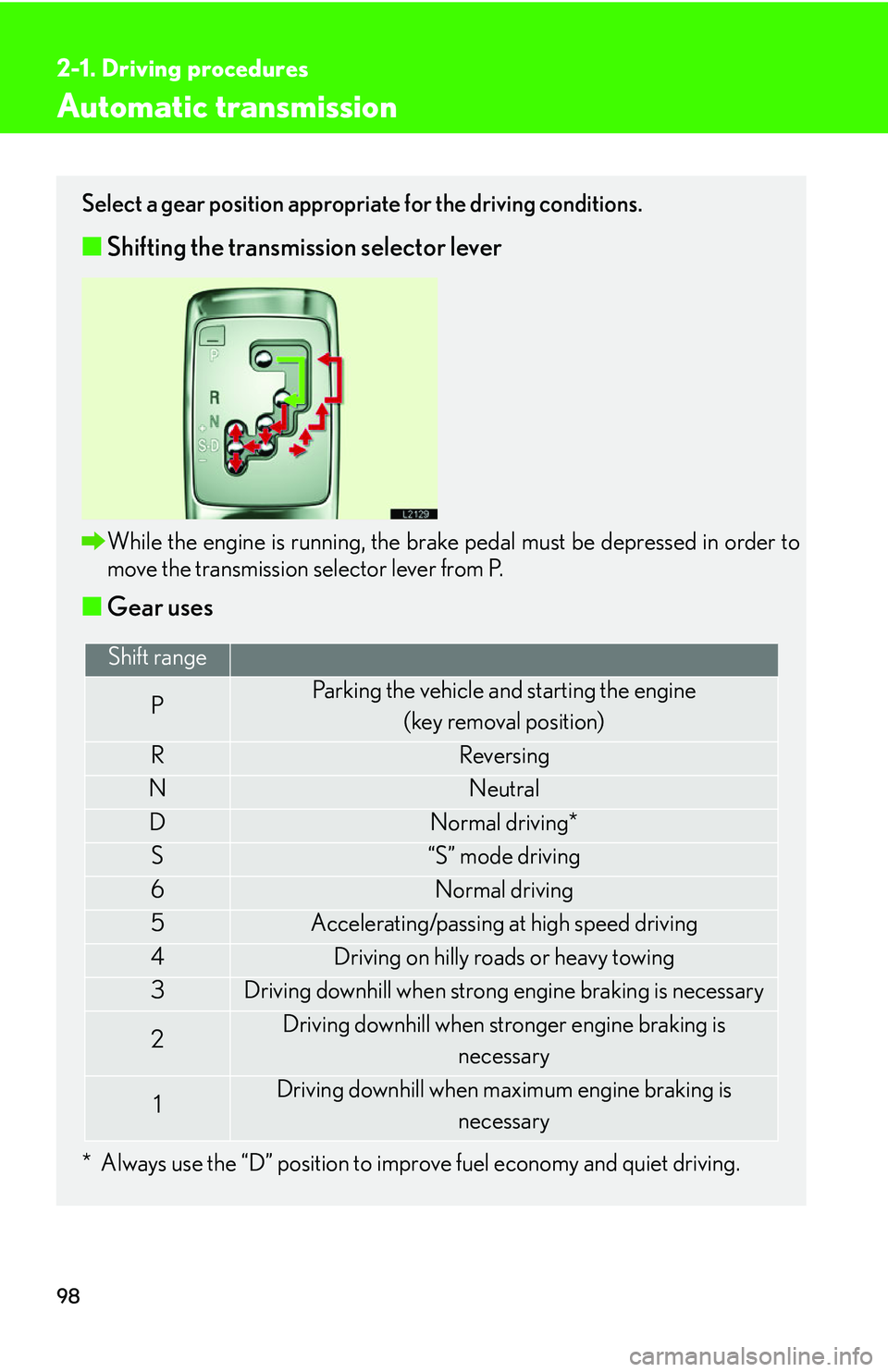
98
2-1. Driving procedures
Automatic transmission
Select a gear position appropriate for the driving conditions.
■Shifting the transmission selector lever
While the engine is running, the brake pedal must be depressed in order to
move the transmission selector lever from P.
■Gear uses
* Always use the “D” position to improve fuel economy and quiet driving.
Shift range
PParking the vehicle and starting the engine
(key removal position)
RReversing
NNeutral
DNormal driving*
S“S” mode driving
6Normal driving
5Accelerating/passing at high speed driving
4Driving on hilly roads or heavy towing
3Driving downhill when strong engine braking is necessary
2Driving downhill when stronger engine braking is necessary
1Driving downhill when maximum engine braking is
necessary
Page 136 of 419
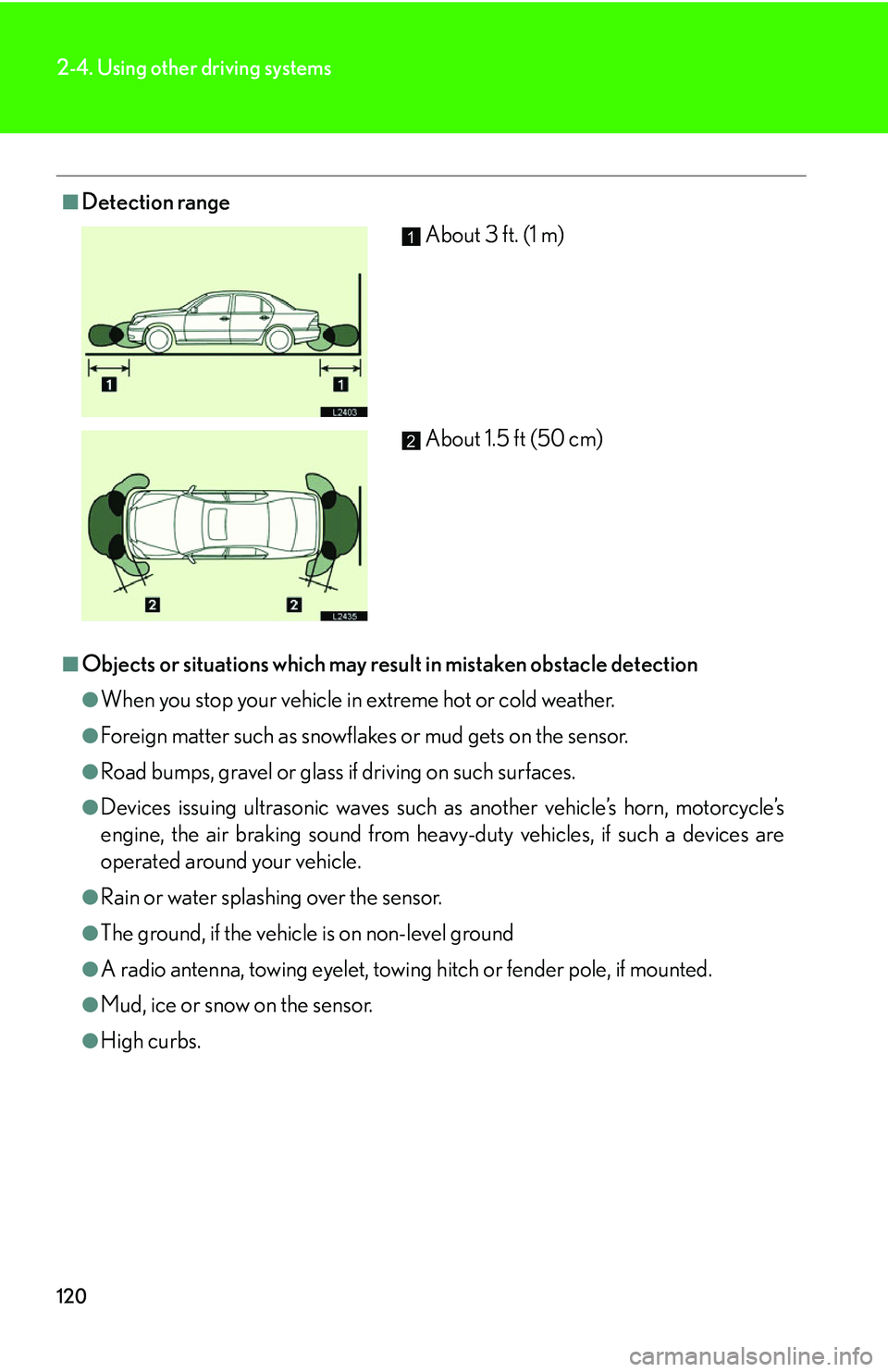
120
2-4. Using other driving systems
■Detection range
■Objects or situations which may result in mistaken obstacle detection
●When you stop your vehicle in extreme hot or cold weather.
●Foreign matter such as snowflakes or mud gets on the sensor.
●Road bumps, gravel or glass if driving on such surfaces.
●Devices issuing ultrasonic waves such as another vehicle’s horn, motorcycle’s
engine, the air braking sound from heavy-duty vehicles, if such a devices are
operated around your vehicle.
●Rain or water splashing over the sensor.
●The ground, if the vehicle is on non-level ground
●A radio antenna, towing eyelet, towing hitch or fender pole, if mounted.
●Mud, ice or snow on the sensor.
●High curbs.
About 3 ft. (1 m)
About 1.5 ft (50 cm)1
2
Page 158 of 419
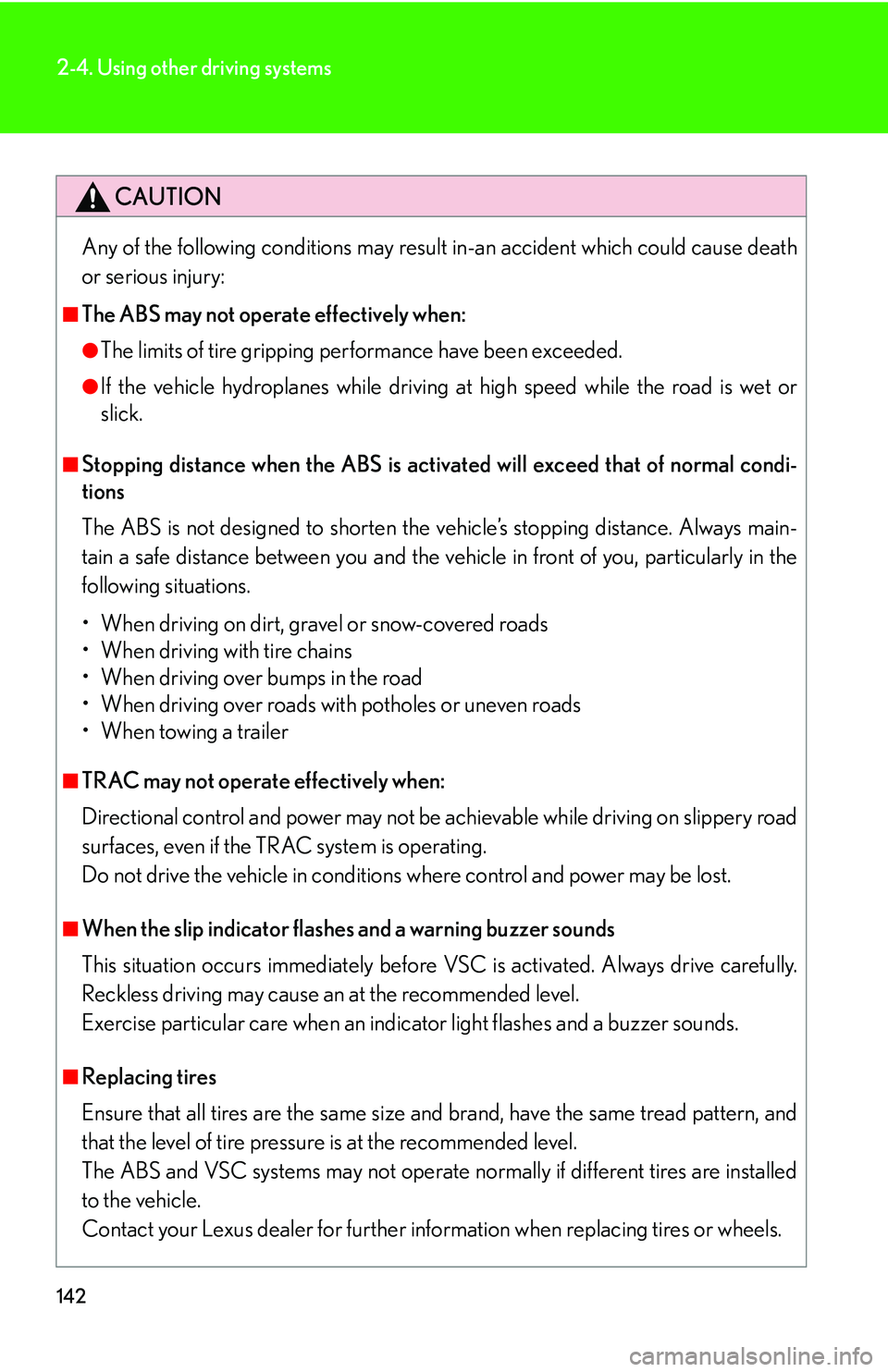
142
2-4. Using other driving systems
CAUTION
Any of the following conditions may result in-an accident which could cause death
or serious injury:
■The ABS may not operate effectively when:
●The limits of tire gripping performance have been exceeded.
●If the vehicle hydroplanes while driving at high speed while the road is wet or
slick.
■Stopping distance when the ABS is activated will exceed that of normal condi -
tions
The ABS is not designed to shorten the v
ehicle’s stopping distance. Always main -
tain a safe distance between you and the vehicle in front of you, particularly in the
fo
llowing situations.
• When driving on dirt, gravel or snow-covered roads
• When driving with tire chains
• When driving over bumps in the road
• When driving over roads with potholes or uneven roads
• When towing a trailer
■TRAC may not operate effectively when:
Directional control and power may not be ac hi
evable while driving on slippery road
surfaces, even if the TRAC system is operating.
Do not drive the vehicle in conditions where control and power may be lost.
■When the slip indicator flashe s and a warning buzzer sounds
This situation occurs immediately before VSC is activated. Always drive carefully.
R
eckless driving may cause an at the recommended level.
Exercise particular care when an indicator light flashes and a buzzer sounds.
■Replacing tires
Ensure that all tires are the same size an d
brand, have the same tread pattern, and
that the level of tire pressure is at the recommended level.
The ABS and VSC systems may not operate no rmal
ly if different tires are installed
to the vehicle.
Contact your Lexus dealer for further info rmati
on when replacing tires or wheels.
Page 161 of 419
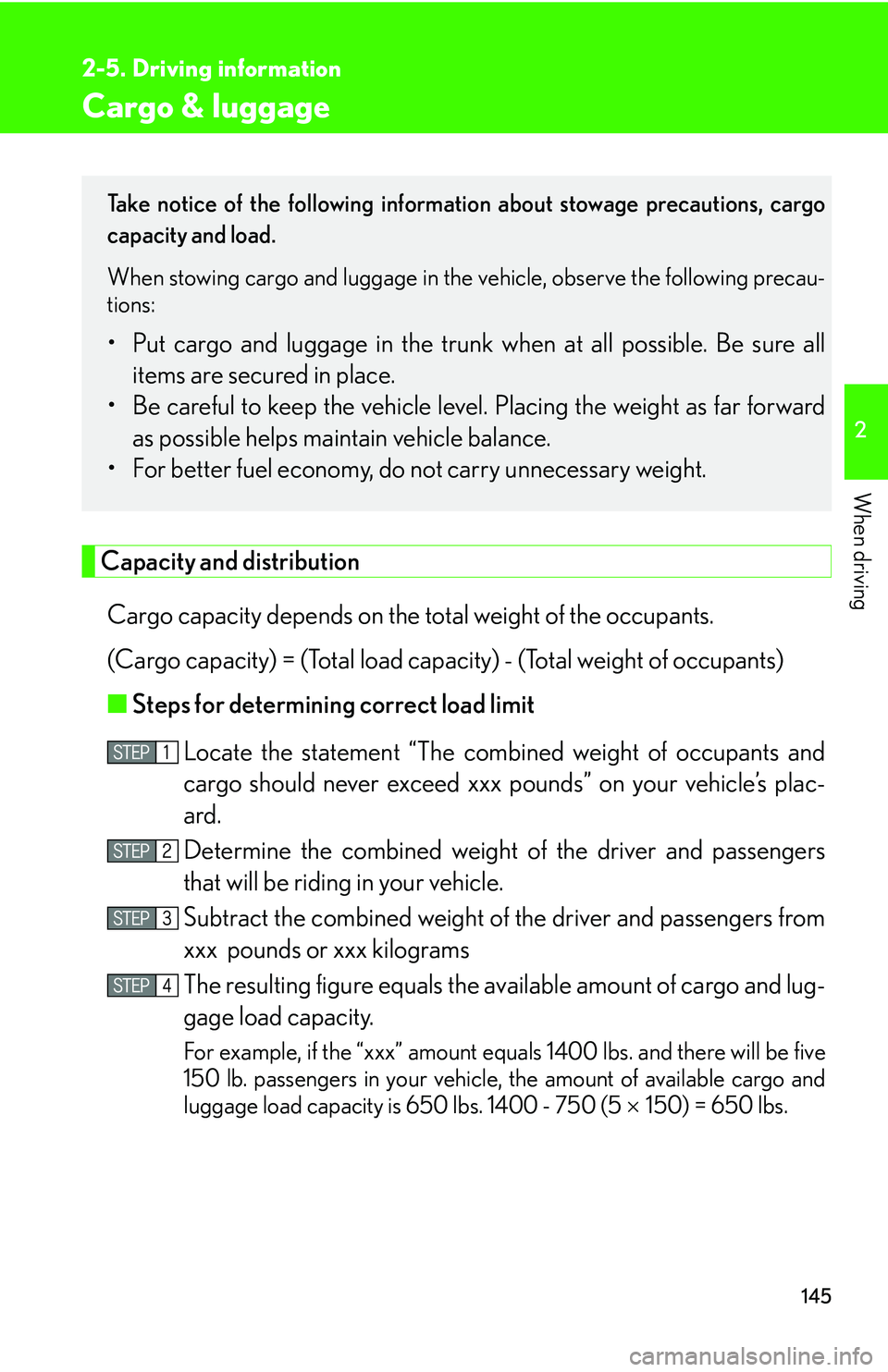
145
2
When driving
2-5. Driving information
Cargo & luggage
Capacity and distribution
Cargo capacity depends on the total weight of the occupants.
(Cargo capacity) = (Total load capacity) - (T
otal weight of occupants)
■ Steps for determining corr
ect load limit
Locate the statement “The combin ed w
eight of occupants and
cargo should never exceed xxx pounds” on your vehicle’s plac -
ard.
Determine the combined weight of the driv
er and passengers
that will be riding in your vehicle.
Subtract the combined weight of the driver and passengers from
xxx pounds or xxx kilograms
The resulting figure equals the available amount of car
go and lug-
gage load capacity.
For example, if the “xxx” amount equa ls 1400 lbs. and there will be five
150 lb. passengers in your vehicle, the amount of available cargo and
luggage load capacity is 650 lbs. 1400 - 750 (5 150) = 650 lbs.
Take notice of the following information about stowage precautions, cargo
capacity and load.
When stowing cargo and luggage in the vehicle, observe the following precau-
tions:
• Put cargo and luggage in the trunk wh en at all possible. Be sure all
items are secured in place.
• Be careful to keep the vehicle level. Placing the w
eight as far forward
as possible helps maintain vehicle balance.
• For better fuel economy, do not carry unnecessary weight.
Page 162 of 419
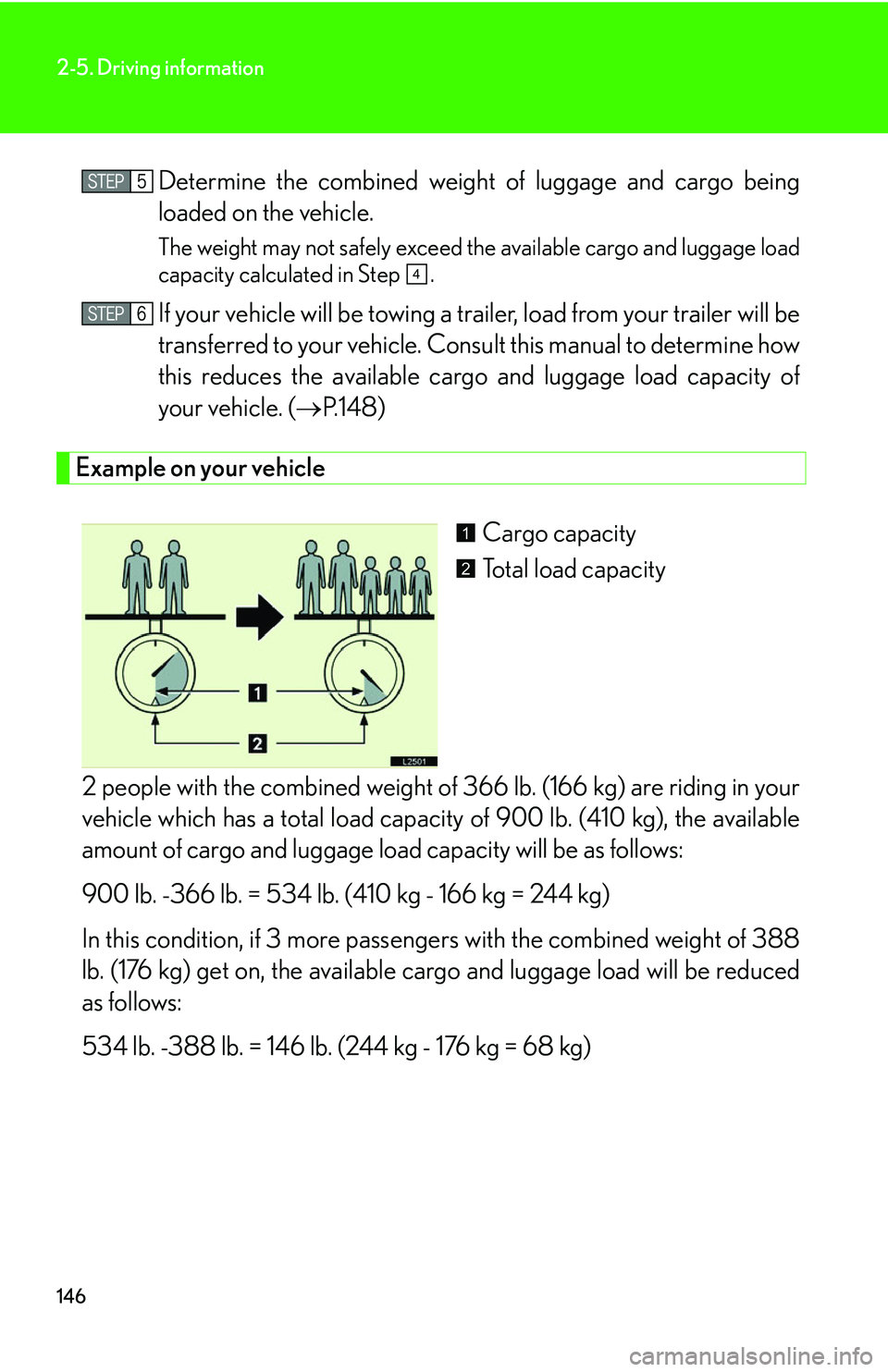
146
2-5. Driving information
Determine the combined weight of luggage and cargo being
loaded on the vehicle.
The weight may not safely exceed the available cargo and luggage load
capacity calculated in Step .
If your vehicle will be towing a trailer, load from your trailer will be
transferred to your vehicle. Consu lt this manual to determine ho
w
this reduces the available cargo and luggage load capacity of
your vehicle. ( P.148 )
Example on your vehicle
Cargo capacity
Total load capacity
2 people with the combined weight of 366 lb. (166 kg) are riding in your
v
ehicle which has a total load capacity of 900 lb. (410 kg), the available
amount of cargo and luggage load capacity will be as follows:
900 lb. -366 lb. = 534 lb. (410 kg - 166 kg = 244 kg)
In this condition, if 3 mor
e passengers with the combined weight of 388
lb. (176 kg) get on, the available cargo and luggage load will be reduced
as follows:
534 lb. -388 lb. = 146 lb. (244 kg - 176 kg = 68 kg)
4
1
2
Page 164 of 419
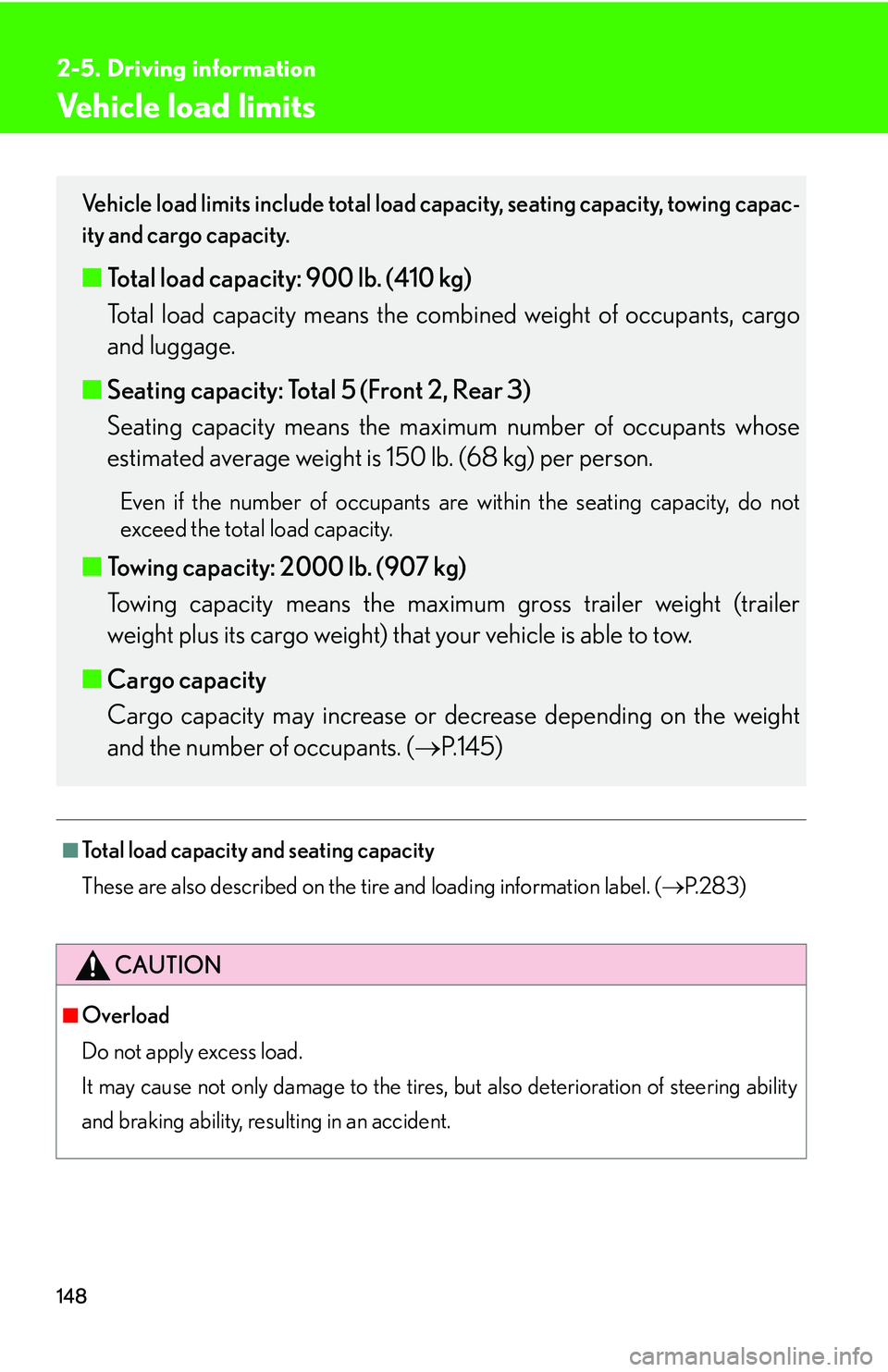
148
2-5. Driving information
Vehicle load limits
■Total load capacity and seating capacity
These are also described on the tire and loading information label. ( P. 2 8 3 )
CAUTION
■Overload
Do not apply excess load.
It may cause not only damage to the tires, but also
deterioration of steering ability
and braking ability, resu lting in an accident.
Vehicle load limits include total load ca pacity, seating capacity, towing capac-
ity and cargo capacity.
■ Total load capacity: 900 lb. (410 kg)
Total load capacity means the comb ined w
eight of occupants, cargo
and luggage.
■ Seating capacity: T
otal 5 (Front 2, Rear 3)
Seating capacity means the maxi mum number of occupants whose
estimated a
verage weight is 150 lb. (68 kg) per person.
Even if the number of occupants ar e within the seating capacity, do not
exceed the total load capacity.
■ Towing capacity: 2000 lb. (907 kg)
Towing capacity means the maximum gross trailer weight (trailer
w
eight plus its cargo weight) that your vehicle is able to tow.
■ Car
go capacity
Cargo capacity ma y incr
ease or decrease depending on the weight
and the number of occupants. ( P.145 )